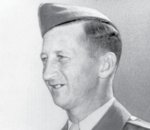


Roadway signs commemorating Hub City as the home of World War II Congressional Medal of Honor recipient Dexter Kerstetter are likely to go up after the Centralia City Council passed a measure Tuesday approving installation of the signs.
To the public’s knowledge, Kerstetter, who died in 1972, is the only U.S. veteran born in Centralia to have received the Medal of Honor. Two signs — one along Mellen Street and another along North Pearl Street — will soon greet visitors, proclaiming the city as the “Home of WW II Medal of Honor Recipient Dexter J Kerstetter.”
To lifelong Centralian Al Gray, 81, this marks a big step foward in commemorating the life and war accomplishments of a native Centralian.
“I’d actually like to see one of them off each exit on I-5, but two’s a start,” he told The Chronicle. “I didn’t think the wheels of government ran this smoothly.”
According to the U.S. Congressional Medal of Honor Society, the accolade is the “United States’ highest award for military valor in action” for any U.S. service member who “distinguishes himself conspicuously by gallantry and intrepidity at the risk of his life above and beyond the call of duty; (or) while engaged in an action against an enemy of the United States; (or) while engaged in military operations involving conflict with an opposing foreign force; or while serving with friendly foreign forces engaged in an armed conflict against an opposing armed force in which the United States is not a belligerent party.”
The award has been given to only 3,527 service members in its 160 years of existence. Following a rigorous application and verification process, the Medal of Honor is often awarded to the soldier by the president at a public ceremony.
Private First Class Kerstetter was born on Dec. 21, 1907. The actions that led him to the Medal of Honor took place near a village on Luzon Island, in the Phillipine islands, on April 13, 1945.
He was part of a unit that was initiating a dawn attack against Japanese troops who were positioned atop a hill with only a small number of narrow ridges that were heavily guarded with mortars, machine guns and rifles. After being stopped by intense gunfire, Kerstetter led his squad past the line and up the hill.
In total, Kerstetter killed 16 Japanese soldiers that day as he fired his rifle and threw grenades at the scattering opposition, according to the Medal of Honor Society.
“The hill was taken and held against the enemy's counter attacks, which continued for three days. Pfc. Kerstetter’s dauntless and gallant heroism was largely responsible for the capture of this key enemy position, and his fearless attack in the face of great odds was an inspiration to his comrades in their dangerous task,” read the Medal of Honor Society citation.
Kerstetter’s actions were honored by President Truman at the White House on Oct. 12, 1945. He left the U.S. Army with the rank of sergeant. He reportedly died in 1972 during a fishing accident in Hood Canal.
Gray, a former firefighter, said this effort to bring a sign proposition forward to the council has been in the works since 2019. As the coronavirus pandemic affected life, the effort stalled.
Chronicle columnist Bill Moeller, who wrote a pair of columns about Gray and his effort, lamented that perhaps it was because not enough people knew of Kerstetter and his war efforts.
“I never did really meet Mr. Kerstetter, although I was raised over in the Logan District and his family was over there,” Gray said. “I just think it’d be a fine addition to our community and is something that’s probably long overdue.”
Gray said he was inspired by similar roadway signs nearby, including a Bronze Star recognition in Rainier and the recent naming of the Regina Clark Bridge in Centralia on state Route 507.
Gray said he couldn’t have done this without Public Works Director Kim Ashmore. City staff worked with the Washington State Department of Transportation on the sign and its location. The project has the support of WSDOT, according to city documents.